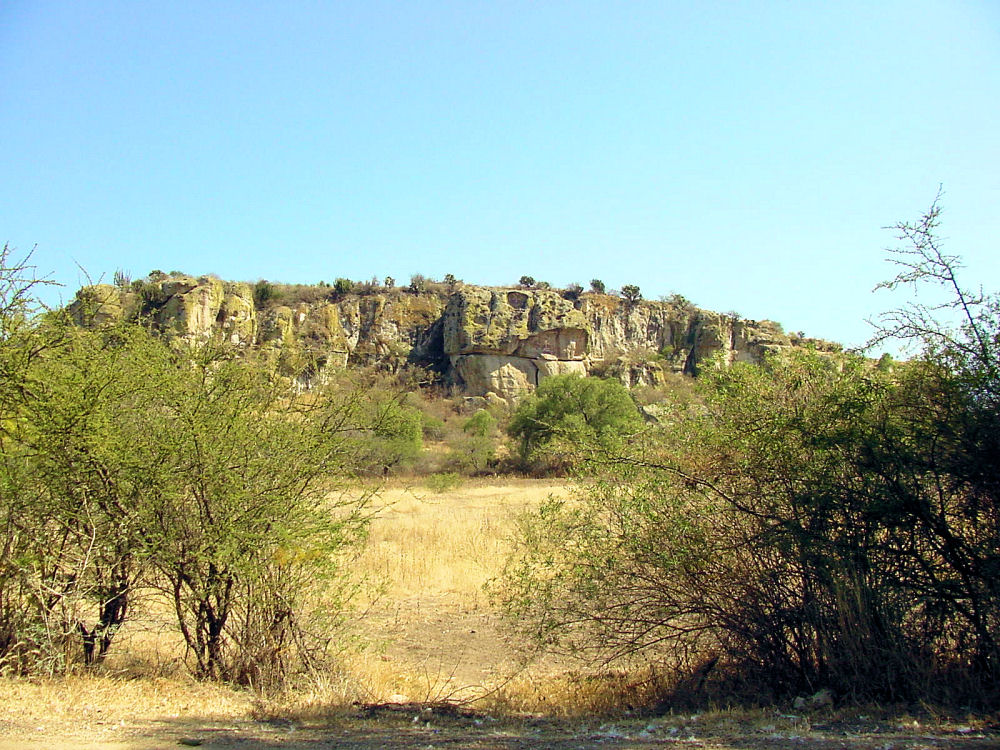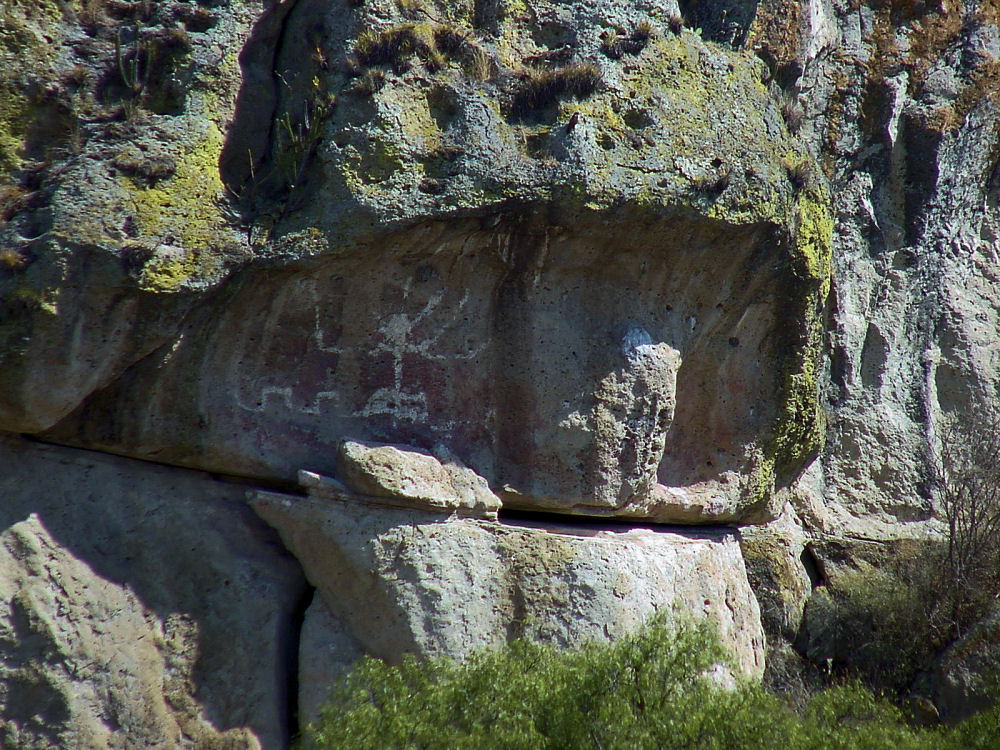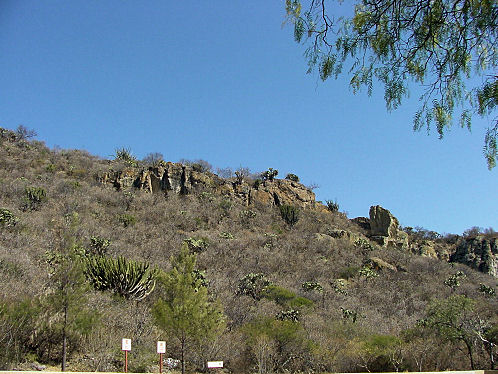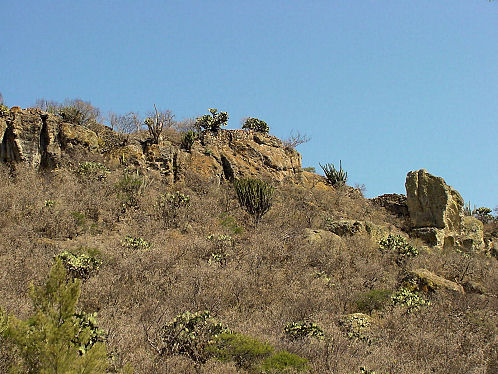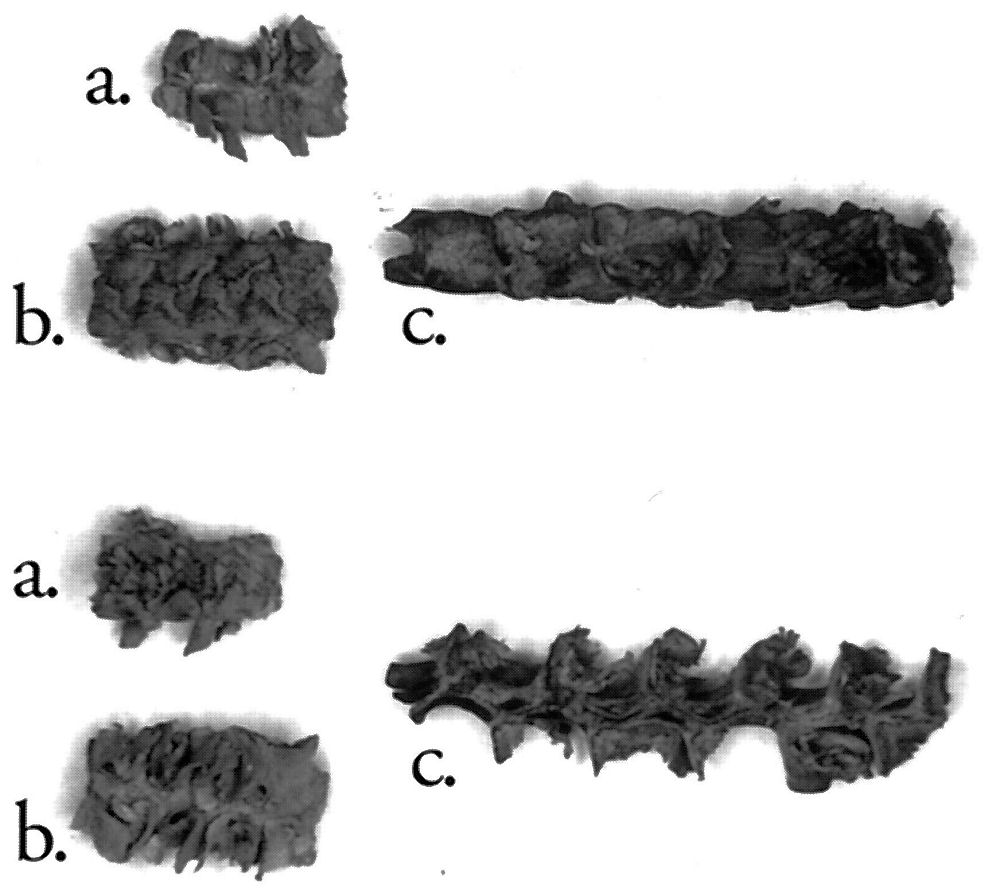We wish to thank Wikipedia, the free encyclopedia, for some of the images and information which we were able to receive from them. We share our images, and information, also with Wikipedia.
Tlacolula Valley Caves:
To date, archaeologists have found approximately 100 caves and rock shelters in the Central Valley of Oaxaca (Tehuacan valley), Mexico; near the ancient cities of Yagul and Mitla, which contain evidence of pre-historic human habitation.
The caves and rock shelters vary in size and what they contain. Many contain paintings and other forms of graphic representation. Several of their contents include ceramics and stone tools.
They include early forms of corn materials which show similarities to the first vestiges of the domestication of wheat and rye in the Middle East.
One of the deepest caves is called the Cueva de la Paloma. The caves have been studied since the 1960s, especially the Cueva de Guilá Naquitz (meaning white stone in Zapotec), which has some of the best evidence for the domestication of corn and squash, which dates back more than 10,000 years. Other caves, such as those near Yagual and Mitla confirm findings at Guilá Naquitz and show human occupation to about 8000 years BCE the sites also show similarities to the Head Smashed and Buffalo Jump Complex sites in Canada.
Many more smaller caves with similar artifacts are thought to exist in the area.
Some of these caves, & shelters provide archaeological, and rock-art evidence for the progress of the nomadic hunter-gathers to become incipient farmers.
Thus, it is believed that the cultural landscape of the Prehistoric Caves of Yagul and Mitla, in the Valley of Oaxaca demonstrates the link between man and nature that gave origin to the domestication of plants in North America, thus allowing the rise of Mesoamerican civilizations.
Guilá Naquitz Cave:
The Guilá Naquitz Cave is best known for being the location where Ten thousand-year-old Cucurbitaceae seeds have been found. The Guilá Naquitz, Cucurbitaceae seeds are considered to be the earliest known evidence of domesticated plants found in the continent, while corn cob fragments from the same cave are said to be the earliest documented evidence for the domestication of maize.
Guilá Naquitz was excavated in the 1970s by a team from the University of Michigan led by Kent Flannery.
Three cobs of teosinte (the wild progenitor of maize) were found within the deposits and direct-dated by AMS radiocarbon dating to about 5,400 years old; they show some signs of domestication.
If that is correct, the Guila Naquitz domesticated teosinte is older than that from the other Tehuacan valley sites by about 700 years.
Guilá Naquitz is a small cave located within the eastern range of mountains in the Valley of Oaxaca. This is in the Tlacolula Valley arm of the Valley of Oaxaca.
Archaeologists say that Guilá Naquitz was occupied at least six times between 8,000 and 6,500 BC, by hunters and gatherers, probably during the fall season (October to December) of the year.
Archaeologists discovered and recovered a wide range of plant food within the cave deposits of Guilá Naquitz, including acorn, pinyon, cactus fruits, hackberries, and most importantly, the wild forms of bottle gourd, squash and beans.
Bottle gourd, squash and beans are considered the "Three Sisters," of Mesoamerican food.
Researchers have taken this to be evidence of early cultivation of bottle gourd, squash and beans.
In Fact; Three cobs of teosinte (the wild progenitor of maize) were found within the deposits and direct-dated by AMS radiocarbon dating to about 5400 years old; they also show some signs of domestication. If that is correct, the Guila Naquitz domesticated teosinte is older than that from the neighboring Tehuacan valley sites by about 700 years.
This is a conclusion supported by the presence of maize pollen in various archaeological and paleoecological sites from southern Central America and northern South America that date to between ca. 6,600 and 4,700 14C years B.P
On Sunday, August 1, 2010, © UNESCO declared these caves as a World Heritage Site.
Note: While the evidence found at Guilá Naquitz Cave is well researched and exciting, it is not conclusive as to the first cultivation of corn. Scientists admit that they are still searching and new evidence may be discovered.
Guilá Naquitz Caves, Historical Description:
Hunter-gatherers followed nomadic lives in the area up to the end of the Ice Age, some 10,000 years ago, and, with the improvement in climate gradually moved towards a more settled way of life. Evidence of this gradual evolution, with the progressive domestication and improvement of plant species leading to an eventual agriculture-based society, and evidence of this gradual change has been preserved in two of the perpetually dry caves and one open site.
Sixty caves and rock shelters were surveyed in the 1960s by Kevin V Flannery. He excavated four sites: Guilá Naquitz and Cueva Blanca caves, the Martinez rock shelter, and also the open site of Gheo Shih (outside the nominated area). This work was seen to have produced evidence of the shift from nomadic to semi-sedentary lifestyles. Only three sites out of all the 147 caves and sites have provided botanical evidence. These are, Guilá Naquitz, Cueva Blanca and Gheo Shih. Some of the finds from Flannery's excavation are deposited in the Museum of the Cultures of Oaxaca, in Oaxaca City. Others were subjected to destructive testing and no longer exist.
In 1996 further exploration produced an inventory of plants on the property and in 2001 surveys identified caves not recorded in the 1960s.
Work was undertaken by the University of Michigan between 1970-80 on the cultural ecology of the Valley. The caves and rock shelters were further studied in 1995 by Victoria Arriola. From 1996 intensive research has continued, in particular, through the efforts of the National Institute of Anthropology and History. Finds from the Naquitz cave have been also been re-assessed by the Smithsonian Institution through accelerator mass spectrometry (AMS) radiocarbon dating, along with finds of early domesticated plant assemblages that were recovered in the 1950s and 1960s from four other caves in Mexico: Tamaulipas (Romero's and Valenzuela's Caves), and Tehuacán (Coxcatlan and San Marcos Caves).
In Oaxaca, evidence for the beginnings of plant domestication and settled agriculture during the period between 8,900 and 2,000 BC has been divided into four phases: Naquitz, Jicaras, Blanca and Martinez, after three of the four sites that provided evidence. In the Naquitz phase (8,900-6,700 BC) within the Paleo- Indian period, evidence from Guilá Naquitz cave has been found for domestication of local plants including gourds, squash, beans and corn.
The Jicaras phase (5,000-4,000 BC) is related to evidence from Gheo Shih site, an open encampment, which seems to have seen seasonal and temporary use.
The Blanca phases (3,300-2,800 BC) relates to finds of projectiles from the Cueva Blanca cave linked to more permanent settlements.
The gradual shift from social groups based primarily on hunting to ones that were primarily based on settled agriculture took place in multiple areas at the same time across the Mesoamerican region.
The nominated property at the time it was excavated produced some of the earliest examples of domesticated plants. Although the evidence is acknowledged as being fragmentary, it is seen to outline this complex process.
In the 40 years since some of the caves on the property were investigated, further research at the Rio Balsas lowlands in south-west Mexico has revealed extensive evidence for the sequence from hunter-gathers gathering a variety of teosinte, the wild ancestor of maize, (7,000 BC), to its domestication and dispersal into the highlands of Oaxaca and other areas. One material difference between the two areas is that the evidence in Rio Balsas for the domestication of corn was based on seed evidence, whereas what was found in Oaxaca was a corn cob. However the seed evidence is much earlier than the corn cob.
The site of Yagul reflects one of a series of small citystates that emerged following the decline of the urban State of Monte Alban (remains inscribed on the World Heritage list in 1987) with its smaller satellite societies across the Valley, such as at the settlement at Caballito Blanco, a network of sites spaced at approximately 5km intervals.
The Yagul site was explored from 1954-61.
With the 16th century Spanish conquest in Oaxaca, land use moved away from the indigenous systems. The village governors were able to retain their lands and did not resist the invasion. Hernán Cortés, who was named the first marquis of the Valley, protected it from the huge changes endured in the Mexico Valley. Few Spaniards were at that stage interested in land acquisition however, by 17th century, large haciendas and labors (small farms with employed labour) had appeared, providing local markets with animal products and grains. Close to Yagul stand the remains of the Soriano hacienda including a decorated chapel.
In the early 20th century, major land and agrarian reforms occurred in Mexico. The community of the Union Zapata in the Valley is an example. It emerged in the 1930s as an ejido, with the former ranch, after considerable struggle, divided among 20 families of landless peons. There was not enough land for the community, it was minimally productive and issues arose over the common land 'the Fortress' with the Mitla community. Resentments continue between the landowners.
Nearby Yagul Archaeological Ruins:
Even though much smaller,the site's architecture is similar in many ways to that of Monte Alban. It's Palace of Six Patios is similar to the Group of the Columns at Mitla. This enormous labyrinth-like structure was inhabited by the ruler, or rulers, of Yagul. This has been totally excavated, and surrounding the six patios are rooms with one or three entrances. The walls are made of stone and clay covered with stucco; the floors are made of red stucco. Some rooms were most certainly closed when the building was occupied. There is a throne in the northwestern patio of the southern room.
On a long, narrow street to the south of the Palace of the Six Patios one finds stone mosaics identical to those at Mitla. The stone floor was quarried from the mountain. This streets ends in a long, narrow room known as the Sala de Consejo (Council Chamber) which was previously decorated with stone mosaics that have since disappeared. One enters the room via a staircase which leads to a large patio. To the west, there is a ceremonial building, and to the the east, the ballcourt.
There s a large ballcourt located between the Palace of the Six Patios and Patio 4. It is aligned on an east west orientation and it is thought the ball game had great religious significance. This ball court is the second largest ballcourt in all of Mesoamerica, second only to Chichen Itza.
Yagul is known locally as Pueblo Viejo (Old Village).
